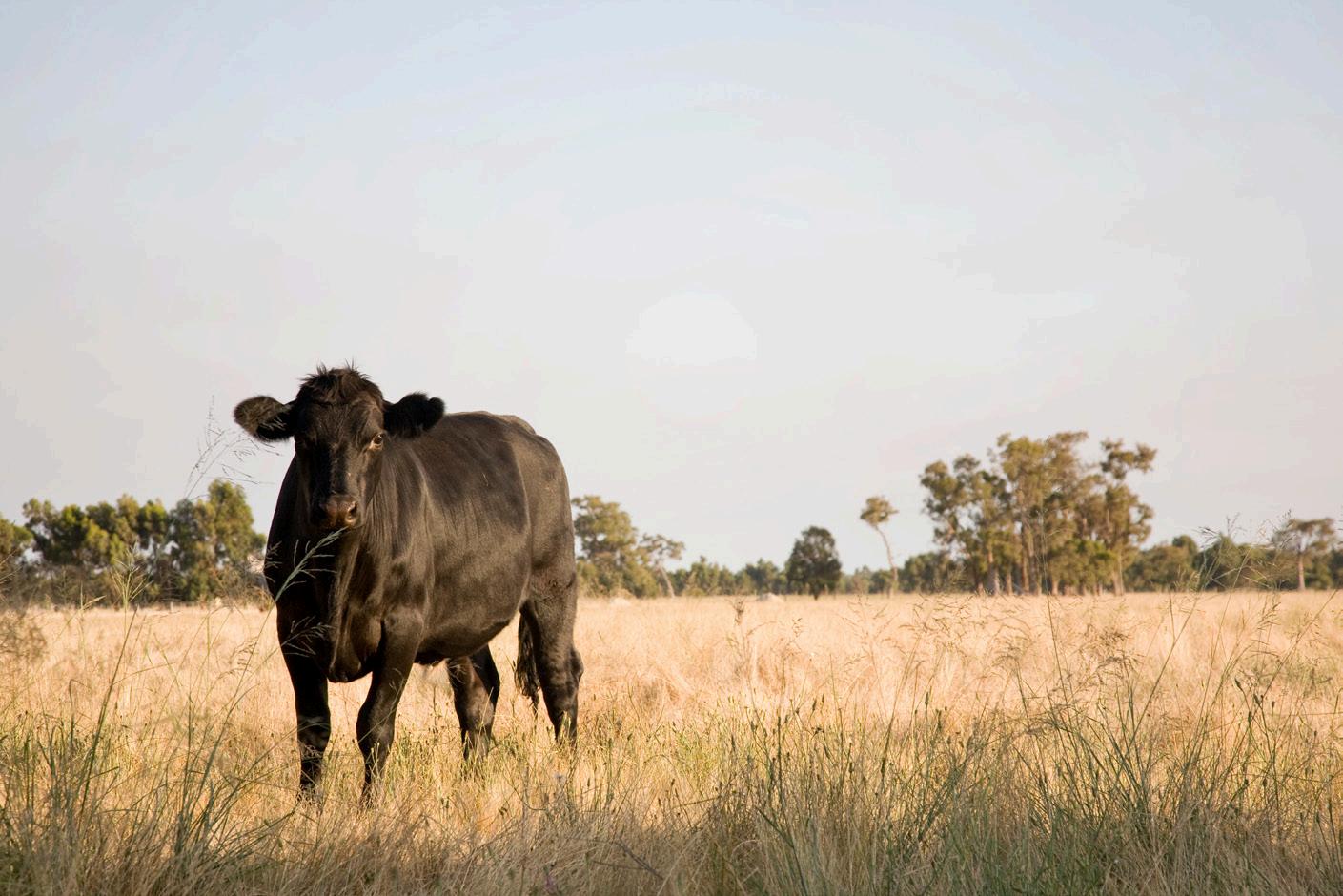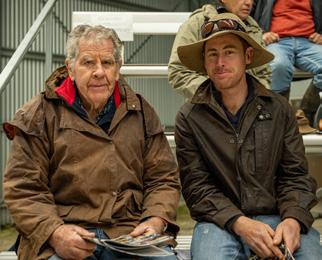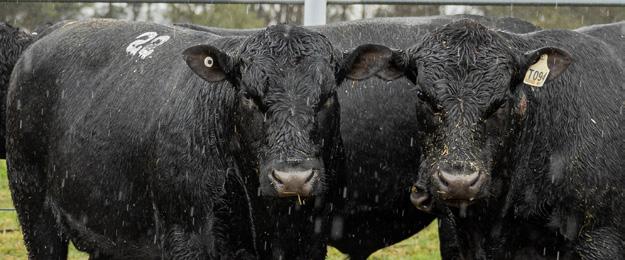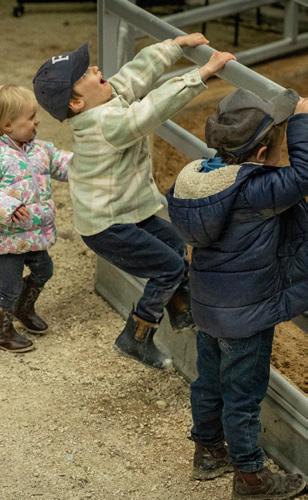
FRIDAY 18 TH JULY 2025, 1PM











FRIDAY 18 TH JULY 2025, 1PM









We invite you to attend our 8th Annual On-Property Auction, where we are proud to offer 46 performance-recorded, rising two-year-old bulls.
This year’s sale features a strong lineup of sires known for their structural soundness, performance data, and proven genetics. The featured sires in our sale include:
Landfall Lorenzo TFAR625 – A long-bodied, structurally sound son of Rennylea L519, purchased at the 2022 Autumn Bull Sale. He displays exceptional maternal and fertility traits, with Rib and P8 fats both ranking in the top 5% of the breed. Lorenzo is extremely docile and easy to handle.
Baldridge Goalkeeper USA19356243 – Combining the best of his sire Sydgen Enhance with improved carcase data. Used successfully over heifers, Goalkeeper has produced moderate framed, easy-doing bulls with a balanced set of figures.
Chiltern Park Quantum GTNQ135 – This impressive Beast Mode son is a robust, high-growth bull with excellent frame. His progeny are strong, growthy bulls well-suited to commercial programs.
Pine View Mogul USA19502726 – A high-indexing sire selected to introduce fresh genetics into our herd. He offers an outstanding growth curve, with NFI in the top 1% and EMA in the top 2% of the breed. Mogul is structurally sound and brings elite carcase traits.
The 2025 sale team presents as a very even line of bulls with strong frame, doability, and excellent temperament — qualities we prioritise heavily in our breeding program. The bulls are in fantastic condition and ready to go to work.
All bulls have undergone rigorous fertility testing, performed by Geoff Steinbeck of Excel Genetics. Individual assessments have been carried out by Liam Cardile, and key results are included in the lot descriptions. A supplementary sheet will also be available on sale day, listing current weight, birth weight, and semen motility. Every Bridgewater Bull has been DNA tested to ensure pedigree integrity, giving buyers full confidence in their purchase. We are confident you will find a bull that will be a valuable asset to your breeding operation.
Let’s pray it is not as wet as our sale day last year. The Flower family
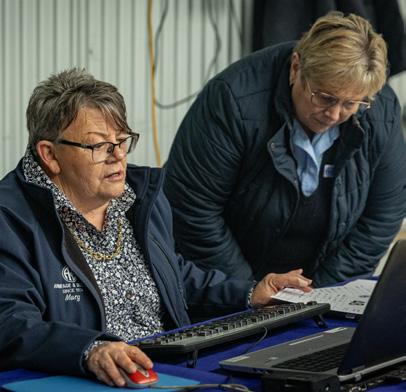
Bridgewater Angus is situated 6km in off the New England Highway 30km north of Armidale and 12km south of Guyra at 278 Toms Gully Road, Black Mountain. If travelling north turn left at the BP Black Mountain Road House into Black Mountain Road proceed through the village of Black Mountain and across the old railway line which becomes Toms Gully Road. Myola is situated 2.8km on the right (stone entrance).
Photos and video footage of all the bulls will be available on our Website www.bridgewaterangus.com.au and on AuctionsPlus approximately two weeks prior to bull sale.
The bulls can be inspected at our Open Day, Friday 11th July between 10am and 2pm and at any other time by contacting Roger Flower 0407 958 224, OR Armitage & Buckley Armidale; Tom Piddington 0429 525 797 Luke Heagney 0458 044 447
On the morning of the sale the bulls will be penned and ready for inspection from 10am.
2% rebate to agents introducing clients 24 hours prior to sale and settling their account under Armitage & Buckley trading terms.
The sale will be conducted under open auction in conjunction with Auctions Plus. Please remember to register with Auctions Plus at least 24 hours prior to the sale and log in early if bidding online. Your livestock agent will assist with this and phone bidding is available if you prefer (please contact one of our agents to organise this).
Once again we shall have our local favourite Barista Chris from Bean Travelin on site from 10am. Morning tea and a JACKS CREEK steak BBQ lunch will be provided on the day of the Sale.


It is our recommendation that insurance is taken out for all purchases. An insurance agent from Nutrien will be available on the day.
All bulls have been ear notched tested free of Pestivirus. They have a full vaccination history since birth have been given a Zoetis 7 in 1, 2 doses of Vibrovax, and have been drenched with CattleMax injectible they have also had Selovin LA and a Multimin.
ALL BULLS IN THIS SALE ARE FREE FROM ALL GENETIC CONDITIONS. The bulls have been semen tested and have undergone morphology by Geoff Steinbeck from Excel Genetics. The Bridgewater Herd has a J-BAS score of 7. All bulls have been structurally assessed by Liam Cardile from LRC Livestock Holbrook.
The bulls have been grazing on crops of rye grass, oats and a multi species pasture since March.
Bridgewater Angus will provide complimentary NLIS transfers (please ensure your PIC No is recorded on the Buyers Registration form). Please also indicate if you would like the registration of your bull transferred to you from the Angus Society.
Bridgewater Angus guarantees the structural soundness and fertility of their Sale Bulls for a period of six moths from the Sale date. The vendor must receive written notification together with a certificate from a registered veterinarian stating the nature of the infertility before the expiration of that period. Animals injured or lost as a result of accident, negligence, or any disease are not covered by this guarantee.

We look forward to welcoming you to our open day, Friday 11th July and to our eighth on property Bull Sale.
Roger, Geralyn and James
Vendor liability relating to infertility claims will not exceed the purchase price of the animal and are limited to a credit equal to the purchase price less the salvage value, which may be utilized at a future Bridgewater Sale.
We select animals with traits of good temperament and ease of handling. However, all animals can be unpredictable, particularly if stressed. Visitors enter pens at their own risk.
- CHILDREN ARE NOT PERMITTED IN PENS
- Do not overcrowd the pens
- Keep movement and noise to a minimum
- Be aware of your surroundings
Buyers can feel confident about the pedigree of the bulls in this Bridgewater Sale, as the bulls have been verified to their sires.
The suffix displayed at the end of each animal’s name indicates the DNA parentage verification that has been conducted by Angus Australia.
PV: both parents have been verified by DNA
SV: the sire has been verified by DNA
DV: the dam has been verified by DNA
#: DNA verification has not been conducted
E: DNA verification has identified that the sire and/or dam may possibly be incorrect, but this cannot be confirmed conclusively
All the bulls have all had genomic and DNA testing done through Neogen Australia.
Every care has been taken in the compilation of this catalogue to ensure the accuracy of information supplied. However, no responsibility will be accepted for any errors which may have occurred.
Bull selection goes beyond just picking the best traits – it is about aligning with your breeding objectives.
Temperament, IMF and a 400D weight top the list for Angus breeders with a focus on improving meat quality. Whether you are focused on IMF or EMA, make informed decisions to enhance your herd’s genetic potential.
“ “











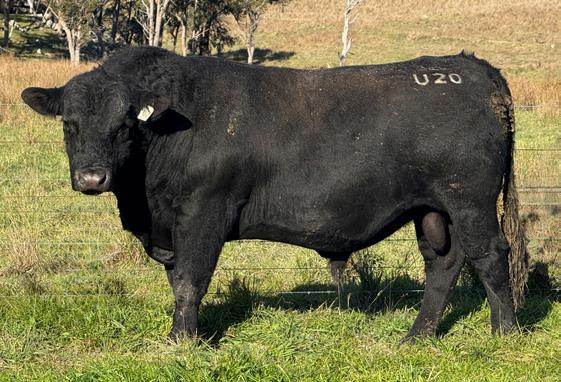
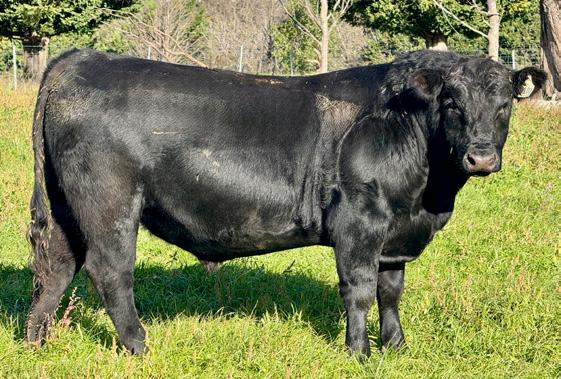





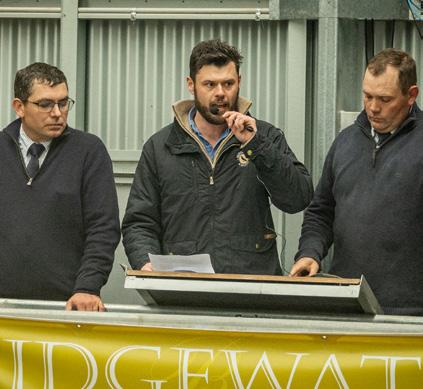










The TransTasman Angus Cattle Evaluation is the genetic evaluation program adopted by Angus Australia for Angus and Angus influenced beef cattle. The TransTasman Angus Cattle Evaluation uses Best Linear Unbiased Prediction (BLUP) technology to produce Estimated Breeding Values (EBVs) of recorded cattle for a range of important production traits (e.g. weight, carcase, fertility).
The TransTasman Angus Cattle Evaluation is an international genetic evaluation and includes pedigree, performance and genomic information from the Angus Australia and Angus New Zealand databases, along with selected information from the American and Canadian Angus Associations.
The TransTasman Angus Cattle Evaluation utilises a range of genetic evaluation software, including the internationally recognised BLUPF90 family of programs, and BREEDPLAN beef genetic evaluation analytical software, as developed by the Animal Genetics and Breeding Unit (AGBU), a joint institute of NSW Agriculture and the University of New England, and Meat and Livestock Australia Limited (MLA).
An animal’s breeding value can be defined as its genetic merit for each trait. While it is not possible to determine an animal’s true breeding value, it is possible to estimate it. These estimates of an animal’s true breeding value are called EBVs (Estimated Breeding Values).
EBVs are expressed as the difference between an individual animal’s genetics and a historical genetic level (i.e. group of animals) within the TACE genetic evaluation, and are reported in the units in which the measurements are taken.
TACE EBVs can be used to estimate the expected difference in the genetics of two animals, with the expected difference equating to half the difference in the EBVs of the animals, all other things being equal (e.g. they are joined to the same animal/s).
For example, a bull with a 200 Day Growth EBV of +60 would be expected to produce progeny that are, on average, 10 kg heavier at 200 days of age than a bull with a 200 Day Growth EBV of +40 kg (i.e. 20 kg difference between the sire’s EBVs, then halved as the sire only contributes half the genetics).
Or similarly, a bull with an IMF EBV of +3.0 would be expected to produce progeny with on average, 1% more intramuscular fat in a 400 kg carcase than a bull with a IMF EBV of +1.0 (i.e. 2% difference between the sire’s EBVs, then halved as the sire only contributes half the genetics).
EBVs can also be used to benchmark an animal’s genetics relative to the genetics of other Angus or Angus infused animals in Australia. To benchmark an animal’s genetics relative to other Angus animals, an animal’s EBV can be compared to the EBV reference tables, which provide:
· the breed average EBV
· the percentile bands table
The current breed average EBV is listed on the bottom of each page in this publication, while the current EBV reference tables are included at the end of these introductory notes.
For easy reference, the percentile band in which an animal’s EBV ranks is also published in association with the EBV.
An accuracy value is published with each EBV, and is usually displayed as a percentage value immediately below the EBV. The accuracy value provides an indication of the reliability of the EBV in estimating the animal’s genetics (or true breeding value), and is an indication of the amount of information that has been used in the calculation of the EBV.
EBVs with accuracy values below 50% should be considered as preliminary or of low accuracy, 50-74% as of medium accuracy, 75-90% of medium to high accuracy, and 90% or greater as high accuracy.

EBVs are calculated for a range of traits within TACE, covering calving ease, growth, fertility, maternal performance, carcase merit, feed efficiency and structural soundness. A description of each EBV included in this publication is provided below.
CEDir % Genetic differences in the ability of a sire’s calves to be born unassisted from 2 year old heifers.
CEDtrs % Genetic differences in the ability of a sire’s daughters to calve unassisted at 2 years of age.
GL days Genetic differences between animals in the length of time from the date of conception to the birth of the calf.
BW kg Genetic differences between animals in calf weight at birth.
200 Day kg Genetic differences between animals in live weight at 200 days of age due to genetics for growth.
400 Day kg Genetic differences between animals in live weight at 400 days of age.
600 Day kg Genetic differences between animals in live weight at 600 days of age.
MCW kg Genetic differences between animals in live weight of cows at 5 years of age.
Milk kg Genetic differences between animals in live weight at 200 days of age due to the maternal contribution of its dam.
DtC days Genetic differences between animals in the time from the start of the joining period (i.e. when the female is introduced to a bull) until subsequent calving.
SS cm Genetic differences between animals in scrotal circumference at 400 days of age.
CWT kg Genetic differences between animals in hot standard carcase weight at 750 days of age.
EMA cm2 Genetic differences between animals in eye muscle area at the 12/13th rib site in a 400 kg carcase.
Rib Fat mm Genetic differences between animals in fat depth at the 12/13th rib site in a 400 kg carcase.
P8 Fat mm Genetic differences between animals in fat depth at the P8 rump site in a 400 kg carcase.
RBY % Genetic differences between animals in boned out saleable meat from a 400 kg carcase.
IMF % Genetic differences between animals in intramuscular fat (marbling) at the 12/13th rib site in a 400 kg carcase.
NFI-F kg/ day Genetic differences between animals in feed intake at a standard weight and rate of weight gain when animals are in a feedlot finishing phase.
Doc % Genetic differences between animals in temperament.
Higher EBVs indicate fewer calving difficulties in 2 year old heifers.
Higher EBVs indicate fewer calving difficulties in 2 year old heifers.
Lower EBVs indicate shorter gestation length.
Lower EBVs indicate lighter birth weight.
Higher EBVs indicate heavier live weight.
Higher EBVs indicate heavier live weight.
Higher EBVs indicate heavier live weight.
Higher EBVs indicate heavier mature weight.
Higher EBVs indicate heavier live weight.
Lower EBVs indicate shorter time to calving.
Higher EBVs indicate larger scrotal circumference.
Higher EBVs indicate heavier carcase weight.
Higher EBVs indicate larger eye muscle area.
Higher EBVs indicate more fat.
Higher EBVs indicate more fat.
Higher EBVs indicate higher yield.
Higher EBVs indicate more intramuscular fat.
Lower EBVs indicate more feed efficiency.
Higher EBVs indicate better temperament.
Foot Angle score Genetic differences in foot angle (strength of pastern, depth of heel). Lower EBVs indicate more desirable foot angle.
Claw Set score Genetic differences in claw set structure (shape and evenness of claws). Lower EBVs indicate more desirable claw structure.
$A $ Genetic differences between animals in net profitability per cow joined in a typical commercial self replacing herd using Angus bulls. This selection index is not specific to a particular market end-point, but identifies animals that will improve overall net profitability in the majority of commercial, self replacing, grass and grain finishing beef production systems.
$A-L $ Genetic differences between animals in net profitability per cow joined in a typical commercial self replacing herd using Angus bulls. This selection index is not specific to a particular market end-point, but identifies animals that will improve overall net profitability in the majority of commercial, self replacing, grass and grain finishing beef production systems.
The $A-L index is similar to the $A index but is modelled on a production system where feed is surplus to requirements for the majority of the year, or the cost of supplying additional feed when animal feed requirements increase is low. While the $A aims to maintain mature cow weight, the $A-L does not aim to limit the increase in mature cow weight as there is minimal cost incurred if the feed maintenance requirements of the female breeding herd increase as a result of selection decisions.
Higher selection indexes indicate greater profitability.
Higher selection indexes indicate greater profitability.
The Beef Class Structural Assessment System uses a 1-9 scoring system for feet and leg structure:
· A score of 5 is ideal
4 and 6 show slight variation from ideal, but this includes most animals. Any animal scoring 4 and 6 would be acceptable in any breeding program
3 and 7 shows greater variation, but would be acceptable in most commercial breeding programs, however seedstock producers should be wary
2 and 8 are low scoring animals and have been culled
Front Feet Claw Set Scoring Range 1 - 9: 1 - open divergent; 5 - good; 9 - extreme scissor claw
Rear Feet Claw Set Scoring Range 1 - 9: 1 - open divergent; 5 - good; 9 - extreme scissor claw. Reference: Shape (primarily curl) and evenness of the claw set.
Rear Feet Angle Scoring Range 1 - 9:1 - steep (stubbed toe); 5 - good; 9 - shallow heel
Front Feet Angle Scoring Range 1 - 9: 1 - steep (stubbed toe); 5 - good; 9 - shallow heel.
Reference: Strength of pastern, depth of heel and length of foot.
Rear Legs Side View Scoring Range 1 - 9: 1 - straight (post legged); 5 - good; 9 - sickle hocked.
Reference: Angle measured at the front of the hock.
Rear Leg Hind View Scoring Range 1 - 9: 1 - bow legged; 5 - good (parallel) ; 9 - cow hocked.
Reference: Direction of the feet when viewed from the rear.
Reference: 1-5 (half scores permitted) using yard test scale below:
1. Docile - The animal is easily held in the corner and the handler can get close enough to put their stick on the animal.
2. Restless - The animal can be held in the corner but exhibits some restlessness and flicking of the tail. The handler cannot get close enough to put their stick on the animal before it moves away.
3. Nervous - The animal is not easily held in the corner even when the handler is some distance back from the animal, continual movement and tail flicking.
4. Flighty (wild) - The animal cannot be held in the corner, frantically runs the fence line and may jump when penned individually, exhibits long flight distance.
5. Aggressive - Similar behavior to score 4 but is also aggressive towards the handler, stares at the handler and threatens to charge or charges (Handler is advised to exit the yard before the animal actually charges).
Scoring Range A - E (includes + and - )
A+ = Double-muscled | A = Extremely heavy muscle | - pronounced creasing between muscles
B = Heavily muscled | - well rounded hindquarter
C = Average muscle | - hindquarter slightly rounded
D = Poor muscle | - narrow concave hindquarter
E = Extremely poor muscle | - angular
Reference: Primarily hindquarter roundness or convexity, width across the stifle and width of stance. Also width and muscle expression across the back, particularly behind the shoulder and in the loin. Jump muscle (about the P8 site) and forearm bulge may be taken into consideration.
Scoring Range 5 - 1:
5 - extremely clean/ tight to body;
1 - extremely pendulous


Armitage & Buckley is one of the New England’s most long standing and reputable Stock, Station & Real Estate Agents, with over 50 years of operation. We have extensive experience in the Agency field, conducting sheep, lamb and cattle sales at the Guyra and Armidale Saleyards. We also conduct our own Weaner Sale each year, participate in the Combined Agents Weaner Sales, Auctionsplus Sales, Annual Bull and Ram Sales, and conduct Clearance Sales. We regularly assist clients with assessment and marketing of livestock, both in the physical and digital space, assist clients with animal husbandry; joining advice; sourcing livestock and bulls; general compliance; and provide help in all matters relating to our client’s livestock enterprise. Give us a call,



